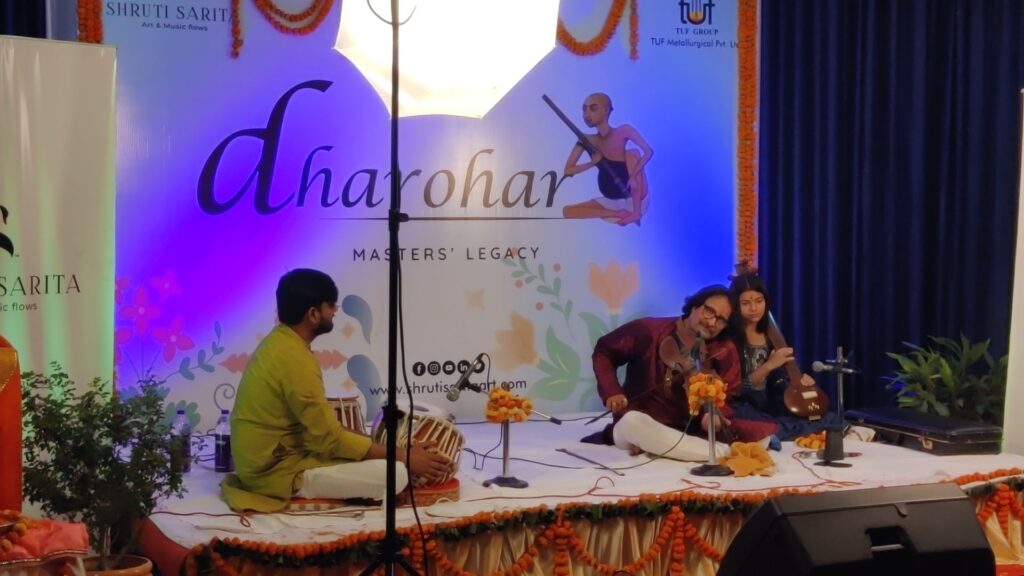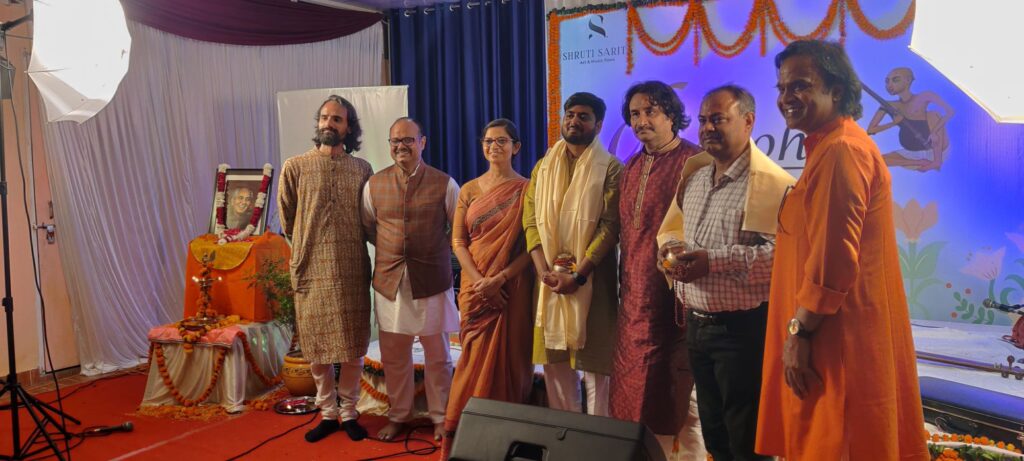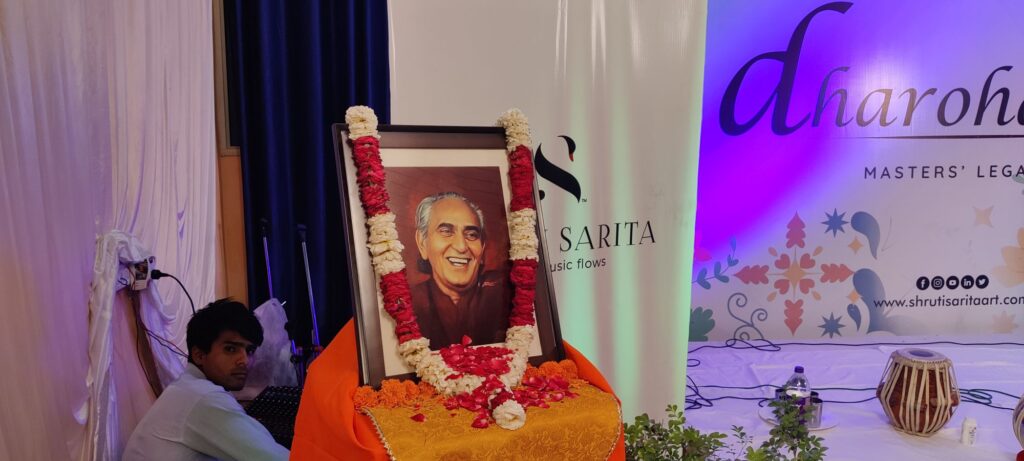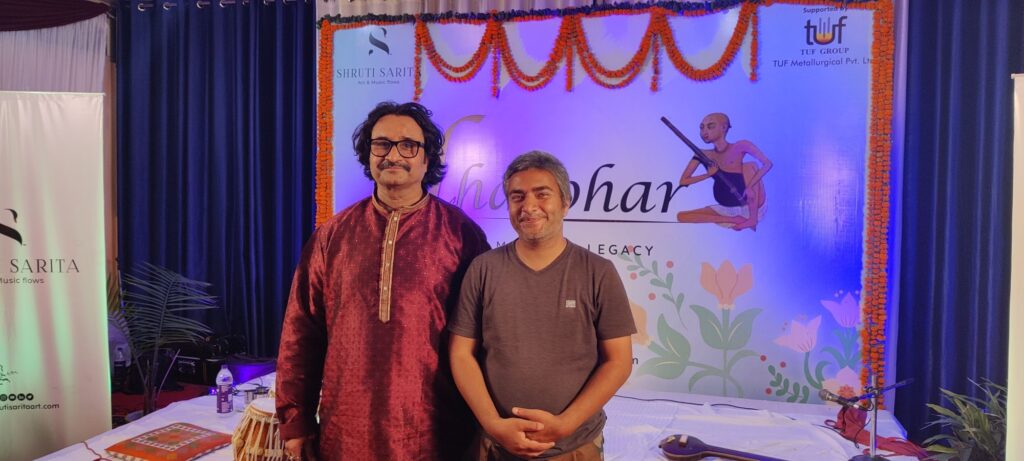DR Santosh Nahar played Violin today at Shruti Sarita Concert Rishikesh India
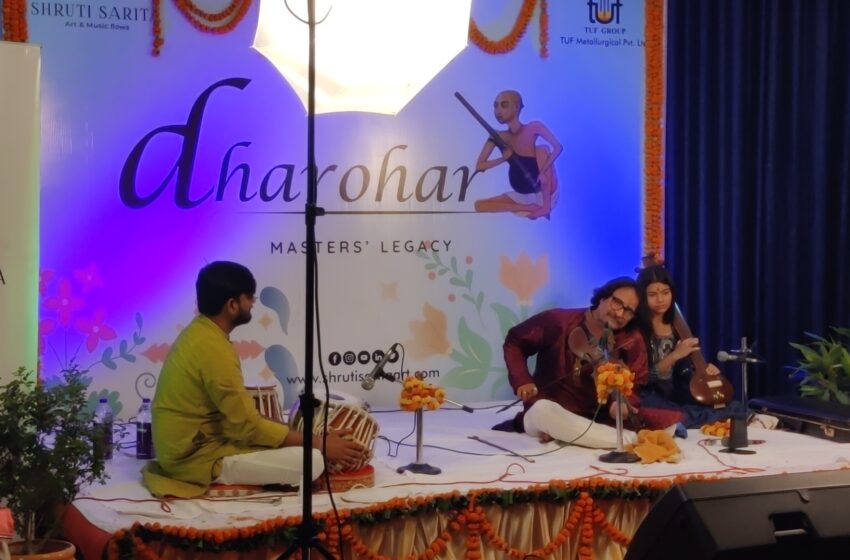
Shruti Sarita Art #Dharohar 2024 Hindustani Classical Violin Recital by Dr. Santosh Nahar, Accompanied by Pradeep Kumar (Tabla)
Dr. Santosh Nahar is known for the unique blend of melody, fluency and purity in the presentation of Raag. His Systematic Bharat in Alaap Chari and both the Vilambit and Drut Gats, with different patterns of ornamental stylish components, fluent Taans and aesthetical feeling according to both Gayaki and Tantra-ang are unique qualities of his performances.
Dr. santosh play violin in raga charukeshi .
raga Charukeshi is a new entrant to Hindustani Classical Music. It exists in the Hindustani style as Raga “Chandramauli”, but was probably popularised by the Carnatic style & therefore has become popular as “Charukeshi”
It is a sampurna raga with Re, Ga as sharp (teevra) notes & Ma, Dha, Ni as Flat (komal) notes- Due to the chalan of the raga, there are nuances of the Bhairav Ang, so many artists perform this raga in the morning.
But traditionally, Charukeshi or Chandramauli has the Kaushik Ang which is dominant thus:
Re Ga Ma Pa, Ga Ma Dha Ni Sa. Sa Ni Dha Ma, Ma Ga Pa, Ma Pa Ga Ma Re Sa
This raga has Ma & Ni as its Vadi & Samvadi swaras. Raga Chandramauli or Charukeshi as it is known today is a late night melody.
North Indian Classical music, each raga has been traditionally associated with a performance time, which supposedly maximizes its aesthetic and emotional effects on the listener. The objective of this work was to investigate the structural basis, if any, for the association of ragas with different times of the 24-hour span. The tonnetz framework has been used to analyze the pitch sets of 65 North Indian Classical ragas, and structural similarities have been observed between ragas associated with (1) times of transition between day and night, i.e., dawn and dusk, and (2) times between these transitions. These findings could provide some insight into the scientific basis of the age-old raga-time relation, and their effects on the perception of the listener.
Indian classical music (ICM) has two main traditions: North Indian classical music (NICM, known as
Hindustani music), and South Indian classical music (SICM, known as Carnatic music). The two differ
in their origins, structure, and lyrical and stylistic aspects. However, both are based on the same
fundamental components: the raga (राग) and tala (ताल).
In NICM, the tala is the rhythmic element upon which melodic improvisation is built, and the raga is the
tonal framework upon which the musician improvises. Similar to the concept of melodic modes in
Western Classical Music (WCM), it consists of a definite set of notes (also known as swaras), or a scale.
Here, the term “pitch set” is used to describe the collection of all notes used in a raga. Moreover, each
raga has a distinctive phrase or sequence of notes, called a pakad, and is characterized by specific note
progressions and musical motifs that give it a unique mood (bhaava, भाव) and emotion (rasa, रस).
In ICM an octave is called a saptak (सतक), and each note is given a name on the basis of the degree on
the scale it represents. They correspond to the following WCM names:
However, there is no strict connection between a raga and its parent thaat; a raga that falls under a thaat
may not include all its notes, and may include other notes as well. Since it is the notes of a raga that
listeners hear during a performance, this study extends the work of Yardi et al. by using a similar
framework to analyze the pitch sets of 65 NICM ragas, to explore possible relationships between the
pitch sets of ragas and their traditionally associated time of day based on the shape of clusters they
2. Method:
This study does a structural analysis of the pitch sets of 65 NICM ragas to explore the basis of raga-time
relation, if any. Following is the list of ragas used in this study and their traditionally associated times of
the day:
1. Day
1.1. First Prahar – 6am to 9am:
1.1.1. Bhairav
1.1.2. Ahir Bhairav
1.1.3. Nat Bhairav
1.1.4. Jogiya
1.1.5. Ramkali
1.1.6. Bilawal
1.1.7. Alhaiya Bilawal
1.1.8. Bairagi
1.2. Second Prahar – 9am to 12 pm:
1.2.1. Deshkar
1.2.2. Asawari
1.2.3. Todi
1.2.4. Basant Mukhari
1.2.5. Jaunpuri
1.2.6. Shuddh Sarang
1.2.7. Bilaskhani Todi
1.2.8. Charukeshi
1.2.9. Gurjari Todi
1.2.10. Sundarkali
1.2.11. Dev-Gandhar
1.3. Third Prahar – 12pm to 3pm:
1.3.1. Bhimpalasi
1.3.2. Patdeep
1.3.3. Multani
1.3.4. Pilu
1.3.5. Bheem
1.3.6. Dhanashree (Bhairavi Ang)
1.3.7. Dhanashree (Bhimpalasi Ang)
1.3.8. Dhani
1.4. Fourth Prahar – 3pm to 6pm:
1.4.1. Purvi
1.4.2. Marva
14.3. Shree
2. Night
2.1. First Prahar – 6pm to 9pm:
2.1.1. Yaman/Kalyan
2.1.2. Kedar
2.1.3. Bhoopali
2.1.4. Shuddh Kalyan
2.1.5. Kamod
2.1.6. Shyam Kalyan
2.2. Second Prahar – 9pm to 12am:
2.2.1. Jog
2.2.2. Bihag
2.2.3. Maru Bihag
2.2.4. Bageshree
2.2.5. Rageshree
2.2.6. Chandrakauns
2.2.7. Puriya
2.2.8. Abhogi Kanada
2.2.9. Gorakh Kalyan
2.2.10. Gunji Kanada
2.2.11. Bageshree Kanada
2.2.12. Kafi
2.2.13. Malhar
2.2.14. Basant
2.2.15. Khamaj
2.2.16. Jaijaivanti
2.2.17. Durga
2.2.18. Hansadhwani
2.3. Third Prahar – 12am to 3am:
2.3.1. Malkauns
2.3.2. Darbari Kanada
2.3.3. Kafi Kanada
2.3.4. Hindol
2.3.5. Jogkauns
2.3.6. Malgunji
2.3.7. Shahana Kanada
2.3.8. Kaushi Kanada
2.4. Fourth Prahar – 3am to 6am:
2.4.1. Bhatiyar
2.4.2. Lalit
2.4.3. Sohini
